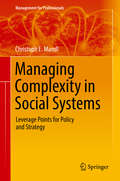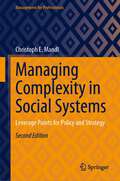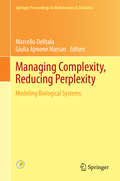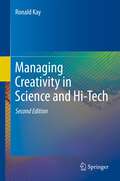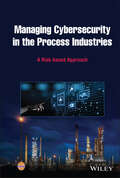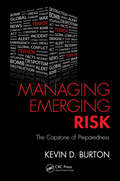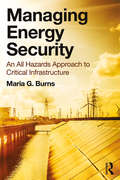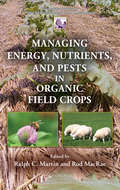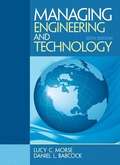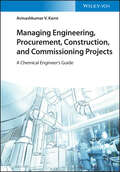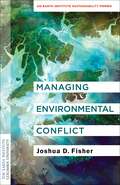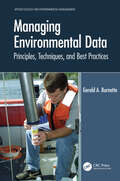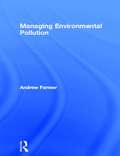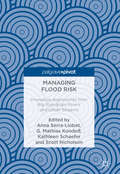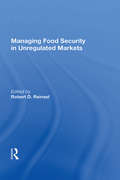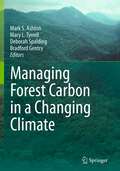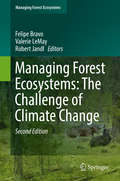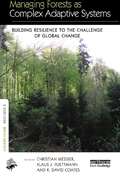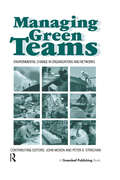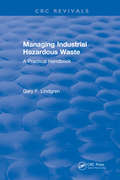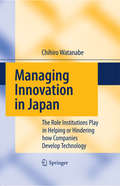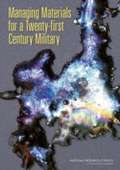- Table View
- List View
Managing Complexity Through Social Intelligence: Foundations of the Modern Organic Corporatist State (Contributions to Political Science)
by Jeremy HorneThis book presents solutions to problems that are total and based on thinking about how and why humans have organized themselves. It discusses how to avoid the now well-documented Holocene Extinction, propelled by climate change, wars, resource depletion, desertification, degrading knowledge quality, famine, and deterioration of societies overall. It explains why we cannot respond effectively with hedonistic, incompetent, corrupt, and anarchistic "liberal democracy" and why neither personality cult regimes can suffice. The book offers a model of an organic social structure embodying a collective consciousness of communitarianism and Platonic-style ethos. Putting an emphasis on the re-establishment of Classical Greek virtue, it offers solutions to resolve identity politics, alienation, and meritocracy. While doing so, the author opposes the "everyone is equal" ideology to govern the section of policymakers, instead circumscribing "rights" in terms of responsibilities, prioritizing education and training to carry forth the ethos of valuing truth above materialism, and developing Durkheim's social brain via a new discipline, "sociointelligence". The book goes on to explain how underpinning these elements is a comprehensive elucidation of often misunderstood words like "liberty", "freedom", "authoritarianism", and "democracy". All of these areas are arranged and combined in uniquely describing the organic society the author deems necessary to avoid human extinction. As a result, the book presents a “new organicity”, where the emerging transhumanism seeks to transcend hydrocarbon-based life with humanly-constructed life.This book will appeal to students, researchers, and scholars of political science, philosophy, and the social sciences interested in a better understanding of complexity, democratic theory, Holocene Extinction, organic thinking, and meritocratic societies.
Managing Complexity in Social Systems: Leverage Points for Policy and Strategy (Management for Professionals)
by Christoph E. MandlWhy do policies and strategies often fail, and what can be done about it? How can complexity be managed in cases where it cannot be reduced? The answers to these questions are anything but trivial, and can only be found by combining insights from complexity science, system dynamics, system theory and systems thinking. Rooted in the seminal works of Gregory Bateson, Jay Forrester, Donella Meadows, Peter Senge, W. Brian Arthur, John Sterman and Thomas Schelling, this book bridges the gap between rigorous science and real-life experience to explore the potential and limitations of leverage points in implementing policies and strategies. It also presents diagnostic tools to help recognize system archetypes, as well as the powerful language of stock and flow diagrams, which allows us to think in terms of circular causality. These tools are subsequently employed to thoroughly analyze particularly thorny problems such as global climate change, the tragedy of the commons, path dependence, diffusion of innovations, and exponential growth of inequality.
Managing Complexity in Social Systems: Leverage Points for Policy and Strategy (Management for Professionals)
by Christoph E. MandlThis book explores how to manage complexity in a highly interconnected world. How can complexity be managed when it cannot be reduced? From organizational addiction to market failure, from limits to growth to the rebound effect, from tragedy of the commons to path dependence, answers are anything but trivial, and can only be found by combining insights from complexity science, system dynamics, system theory and systems thinking. This book bridges the gap between rigorous science and real-life experience to explore the potential and limitations of systems archetypes and their leverage points in implementing effective policies and strategies. It is grounded in Jay Forrester’s language of stock and flow diagrams to address issues of circular causality and causal loops in social systems.The second edition has been completely updated, revised, and extended to thoroughly analyze super wicked problems such as global climate change, climate neutrality, and extremely rapid spread of epidemics. Furthermore, it offers a novel integration of Peter Senge’s concept of systems archetypes with Horst Rittel’s concept of wicked problems. “This text is an important contribution to an emerging field of thought. I have enjoyed and benefitted from reading this text; you will also.”Dennis L. Meadows, Emeritus Professor of Systems Management, University of New Hampshire, USA“This book looks at the world from a different, yet very effective vantage point: the systemic perspective… The author delivers a perfect introduction to systemic thinking, – unorthodox, insightful and practical.” Markus Schwaninger, Emeritus Professor of Management, University of St.Gallen, Switzerland
Managing Complexity, Reducing Perplexity
by Giulia Ajmone Marsan Marcello Delitala"Managing Complexity, Reducing Perplexity" is devoted to an overview of the status of the art in the study of complex systems, with particular focus on the analysis of systems pertaining to living matter. Both senior scientists and young researchers from diverse and prestigious institutions with a deliberately interdisciplinary cut were invited, in order to compare approaches and problems from different disciplines. The common aim of the contributions was to analyze the complexity of living systems by means of new mathematical paradigms that are more adherent to reality and which are able to generate both exploratory and predictive models that are capable of achieving a deeper insight into life science phenomena.
Managing Creativity in Science and Hi-Tech
by Ronald KayAddressing the issues unique to managers of creative technical staff, this guide reflects not only Ronald Kay's long experience observing and teaching successful management techniques, but also treats the expanding challenges due to increasingly globally-based projects and staff. As before, Kay's guide helps readers to prepare themselves, graduate students and others to understand and improve their managerial skills and covers such practical, yet sometimes overlooked, steps such as: individual and team behavior of creative technical staff; managing their own and others' R&D projects; hiring, evaluating and compensating technical staff; R&D proposals and administrative functions; and presentations, meetings and organizational culture. New to this edition are a chapter on the global impact of high-tech enterprises and sections on the roles of foundations and government funding and task-force participation. Also tackled are the basics of starting, financing and staffing venture-capital-funded enterprises. What's more, this book also serves to increase the awareness and knowledge base of anyone who needs to meet the challenge of managing people with the creative energies that drive technologically-based economic growth.
Managing Crises in Tourism: Resilience Strategies from the Caribbean
by Acolla Lewis-Cameron Sherma Roberts Leslie-Ann JordanThis book examines the dilemma of overdependence on tourism in Caribbean countries and territories, and the need for a resilient path to address the industry’s vulnerability in the face of natural disasters. The chapters in the book question how tourism resilience is understood and practiced in Caribbean small island developing states (SIDS) and the factors that inform, undermine, or indeed redefine the sustainable resilience agenda for these territories.With its overreliance on tourism and vulnerability to climate, the Caribbean region finds itself susceptible and in need of an innovative approach in order to survive economically. Contributors to this volume touch on all three sustainability pillars and spanning across many tourism sector considerations, such as product development, stakeholder management, hotel management, marketing and entrepreneurship. By spanning the geography of the Anglophone and Spanish Caribbean this book offers a smorgasbord of conceptual and applied perspectives to researchers in the area of tourism resilience in SIDS. It also presents strategic considerations to public and private sector practitioners in implementing measures to strengthen the competitive positioning of their destinations as they contend with the dynamism of the external and internal environments.
Managing Cyber Attacks in International Law, Business, and Relations
by Jd Scott J. ShackelfordThis book presents a framework to reconceptualize internet governance and better manage cyber attacks. It examines the potential of polycentric regulation to increase accountability through bottom-up action. It also provides a synthesis of the current state of cybersecurity research, bringing features of cyber attacks to light and comparing and contrasting the threat to all relevant stakeholders. Throughout the book, cybersecurity is treated holistically, covering issues in law, science, economics and politics. This interdisciplinary approach is an exemplar of how strategies from different disciplines as well as the private and public sectors may cross-pollinate to enhance cybersecurity. Case studies and examples illustrate what is at stake and identify best practices. The book discusses technical issues of Internet governance and cybersecurity while presenting the material in an informal, straightforward manner. The book is designed to inform readers about the interplay of Internet governance and cybersecurity and the potential of polycentric regulation to help foster cyber peace.
Managing Cybersecurity in the Process Industries: A Risk-based Approach
by CCPS (Center for Chemical Process Safety)The chemical process industry is a rich target for cyber attackers who are intent on causing harm. Current risk management techniques are based on the premise that events are initiated by a single failure and the succeeding sequence of events is predictable. A cyberattack on the Safety, Controls, Alarms, and Interlocks (SCAI) undermines this basic assumption. Each facility should have a Cybersecurity Policy, Implementation Plan and Threat Response Plan in place. The response plan should address how to bring the process to a safe state when controls and safety systems are compromised. The emergency response plan should be updated to reflect different actions that may be appropriate in a sabotage situation. IT professionals, even those working at chemical facilities are primarily focused on the risk to business systems. This book contains guidelines for companies on how to improve their process safety performance by applying Risk Based Process Safety (RBPS) concepts and techniques to the problem of cybersecurity.
Managing Emerging Risk: The Capstone of Preparedness
by Kevin D. BurtonFrom Main Street to Mumbai, Managing Emerging Risk: The Capstone of Preparedness considers the new global drivers behind threats and hazards facing all those tasked with protecting the public and private sector. The text delves into the global mindset of public and private sector emergency managers and presents a new risk landscape vastly different from the one existing ten years ago.The book begins by presenting a series of fictitious scenarios each resulting in mass destruction and fatalities. These are each followed by actual news stories that support the scenarios and demonstrate that the proposed events‘seemingly unthinkable have the potential to occur. Next, the author identifies two drivers in the practice of emergency management and general preparedness today that constitute our view of the future and the new face of risk. The first is the Disaster Halo Effectthe idea that modern threats exhibit more than one event. The second is the worldview of our nation as a Market State focused on the trading of goods, services, and ideas among the nation-states. The book also reviews the history of preparedness and discusses its relationship with large-scale threats, establishing that hindsight bias has hurt our ability to plan and respond to the unexpected.The chapters that follow explore what is needed to better cultivate, design, develop, and operate emerging management and preparedness thinking in the current environment. Each chapter begins with key terms and objectives and ends with thought-provoking questions. Introducing a new paradigm of thought that takes into account the chief influencers of global threats, the book arms emergency and business operations managers with the ammo needed to successfully confront emerging threats in the 21st century.
Managing Energy Security: An All Hazards Approach to Critical Infrastructure
by Maria G. BurnsThis interdisciplinary book is written for government and industry professionals who need a comprehensive, accessible guide to modern energy security. Introducing the ten predominant energy types, both renewable and non-renewable, the book illustrates the modern energy landscape from a geopolitical, commercial, economic and technological perspective. Energy is presented as the powerhouse of global economic activities. To ensure the uninterrupted supply of energy, nations, industries and consumers need to have options. Efficient energy security planning ensures that when a primary energy source is depleted, compromised or interrupted, an alternative energy source must be readily available. For this reason, the foundations of energy security are built upon the five pillars of Sustainability, Independence, Efficiency, Affordability and Accessibility. The numerous case studies presented in this book demonstrate that energy security may be compromised in the absence of one out of these five ingredients. The book also entertains the Triple-E notion of Energy Efficiency, Environmental integrity and Economies of scale, used by governments and corporations for energy optimization. One of the key strengths of the book is its ability effectively to cover various scientific disciplines, and several energy types, while remaining comprehensible. This book will be of much interest to security or logistics professionals, economists and engineers, as well as policymakers.
Managing Energy, Nutrients, and Pests in Organic Field Crops (Integrative Studies in Water Management & Land Development)
by Ralph C. Martin Rod MacRaeThe use of organic management practices in field cropping continues to rise globally, and these methods have proven to be a viable way to produce food with reduced resource use and environmental damage. Managing Energy, Nutrients, and Pests in Organic Field Crops challenges the popular misconception that organic systems are weak at managing energy,
Managing Engineering and Technology, Sixth Edition
by Lucy C. Morse Daniel L. BabcockManaging Engineering and Technology is ideal for courses in Technology Management, Engineering Management, or Introduction to Engineering Technology. This text is also ideal for engineers, scientists, and other technologists interested in enhancing their management skills. Managing Engineering and Technology is designed to teach engineers, scientists, and other technologists the basic management skills they will need to be effective throughout their careers. NOTE: The 2nd printing of the 6th edition of Managing Engineering and Technology is now available as of June 2014.
Managing Engineering, Procurement, Construction, and Commissioning Projects: A Chemical Engineer's Guide
by Avinashkumar V. KarreManaging Engineering, Procurement, Construction, and Commissioning Projects An invaluable real-world guide to managing large-scale and complex Engineering, Procurement, Construction and Commissioning (EPCC) projects Engineering, Procurement, Construction and Commissioning (EPCC) infrastructure projects require engineers from several disciplines to adhere to strict budgetary, scheduling, and performance parameters. Chemical engineers involved in EPCC projects are involved primarily in ensuring that the process plant is designed correctly and safely—interacting with the client, contributing to feasibility studies, selecting specific technologies, developing process flow diagrams, and other key tasks. Managing Engineering, Procurement, Construction, and Commissioning Projects: A Chemical Engineer’s Guide clearly defines the role of a chemical engineer in the EPCC industry and provides detailed and systematic coverage of each phase of an EPCC project. Drawing from their extensive experience in process design, optimization, and analysis, the author identifies and discuss each key task and consideration from a chemical engineer’s perspective. Topics include scope and process planning, construction support, operator training, safety and viability evaluation, and detail engineering. Provides a structured overview of the various challenges chemical engineers face in each project phase Introduces the essential aspects of the Engineering, Procurement, Construction and Commissioning industry Describes the roles of chemical process engineers in each phase of EPCC projects and in different EPCC industry positions Discusses the interaction of process engineers with other disciplines and clients Managing Engineering, Procurement, Construction, and Commissioning Projects: A Chemical Engineer’s Guide is a must-have resource for chemists in industry, process engineers, chemical Engineers, engineering consultants, and project managers and planners working on EPCC projects across the chemical Industry.
Managing Environmental Conflict: An Earth Institute Sustainability Primer (Columbia University Earth Institute Sustainability Primers)
by Joshua D. FisherConflicts frequently arise over environmental issues such as land use, natural resource management, and laws and regulation, emerging from diverging interests and values among stakeholders. This book is a primer on causes of and solutions to such conflicts. It provides a foundational overview of the theory and practice of collaborative approaches to managing environmental disputes.Joshua D. Fisher explains the core concepts in collaborative conflict management and presents a clear, practical, and implementable framework for understanding and responding to environmental disputes. He details strategies to bring stakeholders together in pursuit of collective solutions, emphasizing ongoing processes of dialogue, analysis, action, and learning. This collaborative approach can create new opportunities for stakeholders to better understand each other and the natural world, which enables more effective and context-appropriate environmental governance. The primer examines why and how system dynamics can constrain or expand the possibility of constructive management of conflicts. It features a case study from the Amazon Basin, where local communities, extractive industry operators, conservationists, and land managers have often clashed over access to natural resources, drawing out lessons to illustrate how to adapt the conflict management framework to distinct contexts.Managing Environmental Conflict synthesizes knowledge, methods, and practices spanning consensus building, collaborative governance, complex adaptive systems science, environmental conflict resolution, and environmental peacebuilding. Its presentation of this important and timely topic will be invaluable for academics and practitioners alike, including decision makers, scientists, and conflict management professionals.
Managing Environmental Data: Principles, Techniques, and Best Practices (Applied Ecology and Environmental Management)
by Gerald A. BurnetteFocused on the mechanics of managing environmental data, this book provides guidelines on how to evaluate data requirements, assess tools and techniques, and implement an effective system. Moving beyond the hypothetical, Gerald Burnette illustrates the decision-making processes and the compromises required when applying environmental principles and practices to actual data. Managing Environmental Data explains the basic principles of relational databases, discusses database design, explores user interface options, and examines the process of implementation. Best practices are identified during each portion of the process. The discussion is summarized via the development of a hypothetical environmental data management system. Details of the design help establish a common framework that bridges the gap between data managers, users, and software developers. It is an ideal text for environmental professionals and students. The growth in both volume and complexity of environmental data presents challenges to environmental professionals. Developing better data management skills offers an excellent opportunity to meet these challenges. Gaining knowledge of and experience with data management best practices complements students’ more traditional science education, providing them with the skills required to address complex data requirements.
Managing Environmental Pollution (Routledge Environmental Management)
by Andrew FarmerPresents a comprehensive introduction to the nature of pollution, its impact on the environment, and the practical options and regulatory frameworks for pollution control. Sources of pollution, regulatory controls, technological solutions, management and mitigation techniques and assessment tools, are examined in each key area: air, freshwater, and marine pollution, contaminated land and radioactive substances. Illustrated with a worldwide range of case examples this book offers an invaluable up-to-date guide to both the principles and practice of pollution management.
Managing Flood Risk: Innovative Approaches From Big Floodplain Rivers And Urban Streams
by Scott Nicholson G. Mathias Kondolf Anna Serra-Llobet Kathleen SchaeferThe past half century has seen an evolution in thinking from ‘flood control’ to ‘flood risk management’, recognizing that risk results from both hazard and vulnerability. Rather than rely only on engineering structures to reduce flood magnitude or extent, recent policies emphasize avoiding construction in flood-prone areas (or moving people from floodplains), reducing impacts on exposed populations through early warning systems, and insurance to aid in recovery. Implementing this new approach faces many challenges but also offers opportunities for synergies, as described in this book for a range of large floodplain rivers and smaller urban streams across North America and Europe. This book is unique in presenting the voices of those on the front lines of implementing a new paradigm in flood risk management, each river with a unique set of challenges and opportunities derived from its specific geography as well as differences in governance between the American and European contexts.
Managing Food Security In Unregulated Markets
by Robert D. ReinselThe major grain producing nations are moving toward the reduction of domestic and export subsidies to agriculture. The grain importing nations are reducing import barriers. As world markets evolve, grain will tend to be produced in areas that have a comparative advantage in grain production. Over time, production will shift to least-cost areas. Moving toward market orientation during the 1980's, the United States sharply modified its grain policy so that nonrecourse loans are no longer used as price enhancement devices. The loan rates are established at a percentage below the moving average price and now provide a safety net for prices when aggregate output is much larger than normal in relation to demand. This change tends to remove the United States from its long-term role as residual supplier to the world markets. U.S. grains are more likely to be priced competitively, and stocks are unlikely to accumulate in government storage.
Managing Forest Carbon in a Changing Climate
by Mark S. Ashton Mary L. Tyrrell Bradford Gentry Deborah SpaldingThe aim of this book is to provide an accessible overview for advanced students, resource professionals such as land managers, and policy makers to acquaint themselves with the established science, management practices and policies that facilitate sequestration and allow for the storage of carbon in forests. The book has value to the reader to better understand: a) carbon science and management of forests and wood products; b) the underlying social mechanisms of deforestation; and c) the policy options in order to formulate a cohesive strategy for implementing forest carbon projects and ultimately reducing emissions from forest land use.
Managing Forest Ecosystems: The Challenge of Climate Change
by Robert Jandl Felipe Bravo Valerie LemayClimate change shaped the political agenda during the last decade with three issues as hot topics: commonly making the headlines: carbon budgets, impact and mitigation of climate change. Given the significant role that forests play in the climate system - as sources, sinks, and through carbon trading - this book update the current scientific evidences on the relationships between climate, forest resources and forest management practices around the world. By including the forest scientists' expertise from around the world, the book presents and updates a depth analysis of the current knowledge, and a series of case studies focused on the biological and the economic impacts of climate change in forest ecosystems in Africa, Asia, Europe and North and South America. The book will form a valuable resource for researchers and advanced students dealing with sustainable forestry, climate change issues and the effects of climate change on natural resource management.
Managing Forests as Complex Adaptive Systems: Building Resilience to the Challenge of Global Change (The Earthscan Forest Library)
by Christian Messier K. David Coates Klaus J. PuettmannThis book links the emerging concepts of complexity, complex adaptive system (CAS) and resilience to forest ecology and management. It explores how these concepts can be applied in various forest biomes of the world with their different ecological, economic and social settings, and history. Individual chapters stress different elements of these concepts based on the specific setting and expertise of the authors. Regions and authors have been selected to cover a diversity of viewpoints and emphases, from silviculture and natural forests to forest restoration, and from boreal to tropical forests. The chapters show that there is no single generally applicable approach to forest management that applies to all settings. The first set of chapters provides a global overview of how complexity, CAS and resilience theory can benefit researchers who study forest ecosystems. A second set of chapters provides guidance for managers in understanding how these concepts can help them to facilitate forest ecosystem change and renewal (adapt or self-organize) in the face of global change while still delivering the goods and services desired by humans. The book takes a broad approach by covering a variety of forest biomes and the full range of management goals from timber production to forest restoration to promote the maintenance of biodiversity, quality of water, or carbon storage.
Managing Green Teams: Environmental Change in Organisations and Networks
by Peter Strachan John MoxenTo reach environmental excellence, organizations must unlock and channel the ideas and energies of their staff. This can only be achieved through the effective leadership and commitment of senior managers and the development of sound teamworking throughout the organization. To this end, forward-looking organizations have formulated a range of teams, including: environmental steering committees; environmental action teams; process improvement teams; and quality and environment circles. The aims of this book are to bring together practical experiences and theoretical developments in relation to the role of teamworking within the context of environmental management. Contributions from an international group of leading practitioners and academics present examples of how teamworking can be utilised to solve the complex and uncertain environmental challenges that organisations face. The book is divided into three key sections. The first section examines – in a number of different organizational contexts – the problems that confront managers during the process of forming and developing environmental teams. In the second section, the book examines how environmental teams can trigger changes in core operations and integrate environmental concerns in business decision-making at every level in the organization. In the final section, the focus of the book shifts to environmental networks and their role as inter-organizational co-ordinators. Managing Green Teams: Environmental Change in Organisations and Networks will be of particular interest to educationalists, consultants and practitioners. Teamworking is a well-established field, but, to date, no book has made any attempt to fully integrate teamworking and environmental issues.
Managing Industrial Hazardous Waste- A Practical Handbook
by Gary F. LindgrenHere is your new handbook full of information and guidance necessary to understand and comply with the myriad and complex hazardous waste regulations. This handbook explains the regulations regarding identification and listing of hazardous wastes, walks the reader through the three determinations for all manufacturing firms, gives in-depth explanations of applicable standards, outlines the DOT standards applicable to shippers of hazardous wastes, presents a philosophical basis for corporate compliance, gives "how to" for actions and the paperwork necessary for such a program, and concludes with some practical information not commonly found in textbooks or regulations. This essential resource for personnel with waste management responsibilities at manufacturing firms should prove a valuable resource. This book will assist these practitioners in establishing or modifying regulatory compliance programs. This valuable new book helps you to reduce waste generation, segregate hazardous wastes, reuse on-site or off-site, recycle or reclaim, treat to reduce hazards, secure land disposal, follow regulatory standards, use best management practices, and establish or modify compliance programs.
Managing Innovation in Japan
by Chihiro WatanabeWhy do some country's hi-tech firms innovate better than others? Why did hi-tech firms from the United States outperform such Japanese companies in the 1990s? Through a wealth of empirical evidence, the book compares the development trajectory of manufacturing technology and information technology both between Japanese companies and between companies based in the US, Europe, Australia, India and China. This book shows that institutional systems such as culture, tradition, consumers and local business practices play key roles in how companies develop technology. These factors also influence the very characteristics of the products that the hi-tech firms produce. With a number of case studies the author demonstrates how the most successful and innovative companies recognize these roles and incorporate them into their practices.
Managing Materials for a Twenty-first Century Military
by National Research Council of the National AcademiesSince 1939, the U.S. government, using the National Defense Stockpile (NDS), has been stockpiling critical strategic materials for national defense. The economic and national security environments, however, have changed significantly from the time the NDS was created. Current threats are more varied, production and processing of key materials is more globally dispersed, the global competition for raw materials is increasing, the U.S. military is more dependent on civilian industry, and industry depends far more on just-in-time inventory control. To help determine the significance of these changes for the strategic materials stockpile, the Department of Defense asked the NRC to assess the continuing need for and value of the NDS. This report begins with the historical context of the NDS. It then presents a discussion of raw-materials and minerals supply, an examination of changing defense planning and materials needs, an analysis of modern tools used to manage materials supply chains, and an assessment of current operational practices of the NDS.

